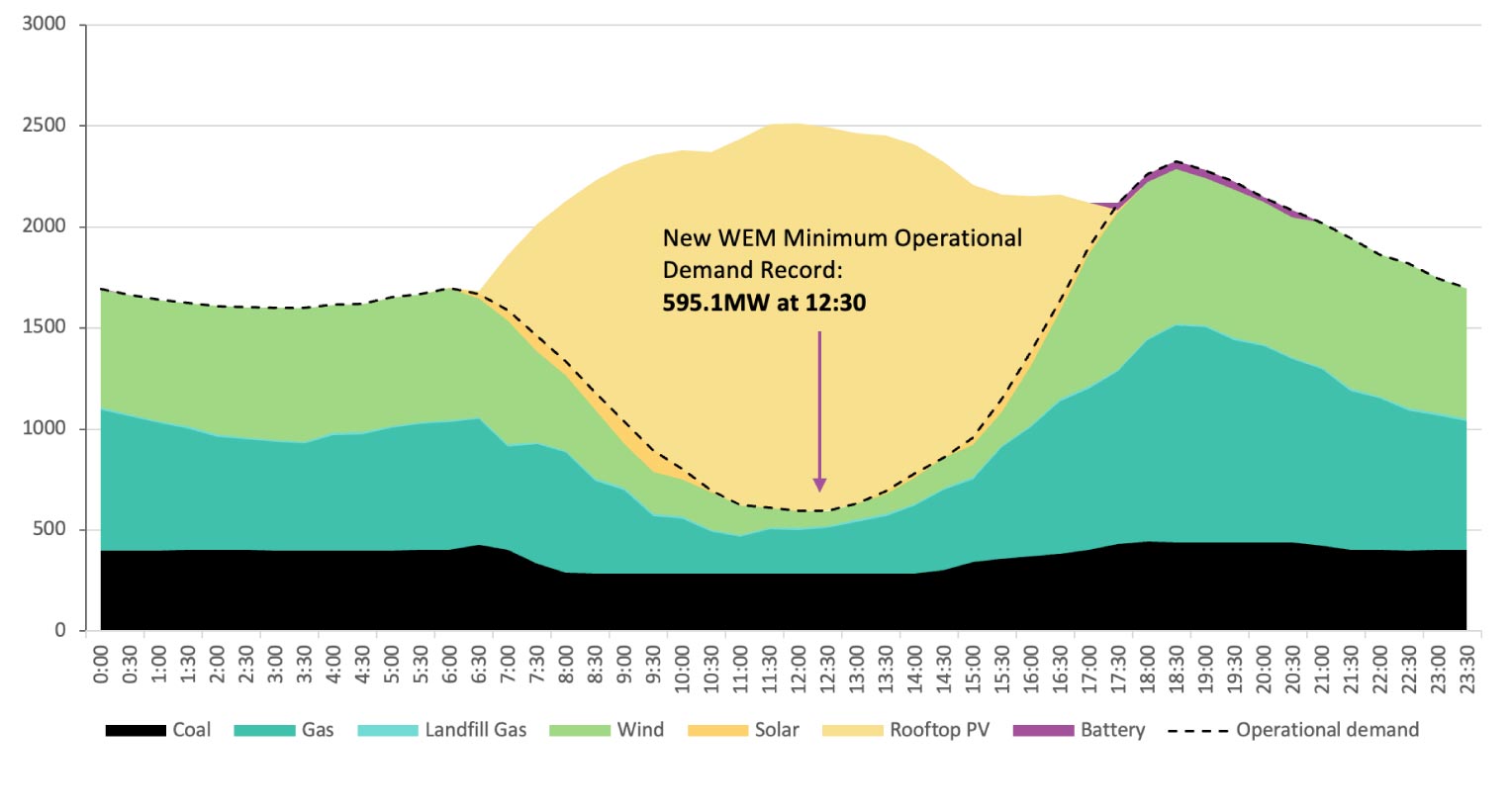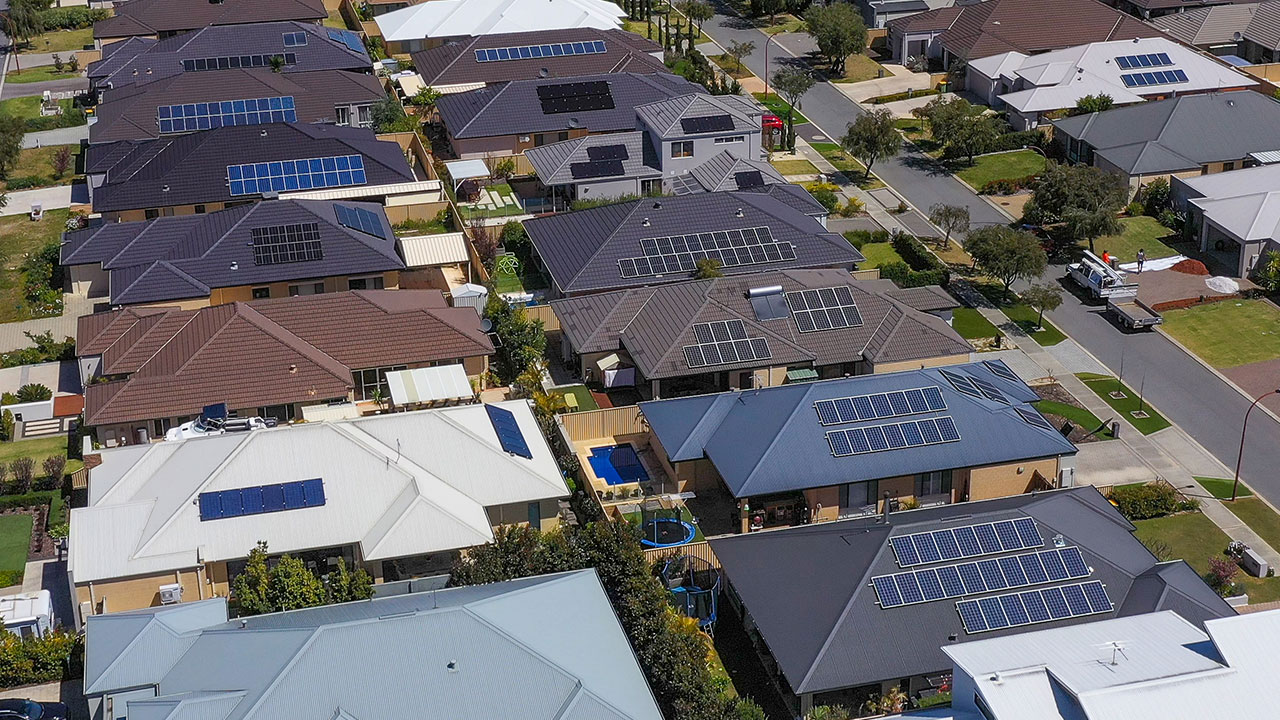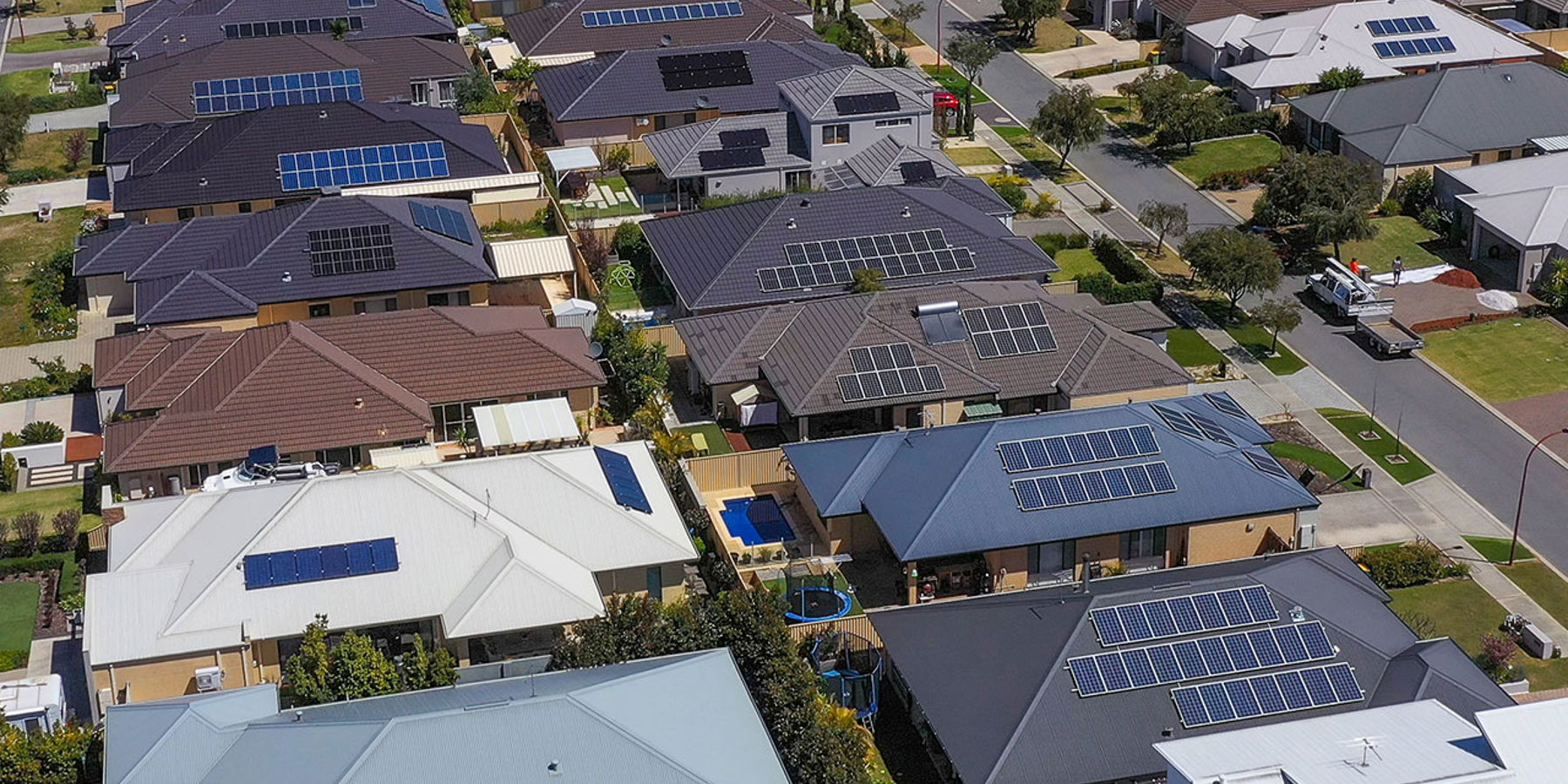Also referred to as low load or system low, and illustrated in the ‘Duck Curve’, Minimum Demand is a challenge facing energy networks around the world.
Minimum Demand is the lowest level of energy demanded from the grid at a point in time. Under certain scenarios it can present challenges that can place the grid under strain and make the energy system vulnerable.
Low demand typically occurs during daylight hours in autumn and spring, on cloud-free sunny days, when temperatures are mild enough that larger energy consuming devices such as heaters, air conditioners and pool pumps aren’t turned on.
It is also more likely on sunny weekends or public holidays, when offices and large industry are off for the weekend and are not using power. The graph below is a clear example of this, with rooftop solar providing more than two-thirds (70%) of the State's electricity needs at that time.
WEM operational demand fuel mix (25 September 2023)

Image source: AEMO DPV Data Dashboard
With one in three households having their own rooftop solar generation, more solar is being exported than we can balance with demand.
At those times, we need to respond to the high quantities of solar being generated and exported into the grid to maintain and ensure grid stability. Without solar management measures, Minimum Demand could lead to widespread outages.
It’s critical that these measures are in place, as it takes far longer to fully restore a power system – a matter of physics, and not unique to Western Australia.

The SWIS is one of the largest stand-alone power grids in the world, around the same size as the United Kingdom and more than four times the size of Tasmania.
However, the number of electricity users is far lower than on other large grids, meaning we have a low density of customer connections.
The SWIS is also a fully islanded grid – it has no interconnectors to other grids. Most, if not all, other large grids rely on interconnectors to help them ride through system balance challenges.
As renewable energy supply increases, we are using fewer thermal generators that can be quickly dispatched to meet energy demand. This can make it difficult to maintain a secure balance when demand is very low.
However we have a number of short and long-term strategies in place to ensure we can manage Minimum Demand and continue to enable more rooftop solar uptake by residents and businesses.
FAQs
Minimum Demand is the lowest level of energy demanded from the grid at any point in time.
Low demand typically occurs during daylight hours in autumn and spring, on cloud-free sunny days, when temperatures are mild enough that large energy consuming devices such as heaters, air conditioners and pool pumps aren’t turned on and rooftop solar is generating the greatest amount of energy.
When these days fall on a weekend or public holiday, when offices and large industry are off and aren’t using power, there is a risk that demand levels can drop to extreme levels.
Under these conditions, AEMO who is responsible for whole electricity system instigates critical measures required to maintain to the security of the power system and stability of the electricity supply in the South West Interconnected System.
Check out AEMO Factsheet: Minimum Demand for more information.
We’ve been transforming the grid to enable greater connection of renewables, particularly rooftop solar. However, on occasions the electricity system can be put under stress when demand is extremely low.
In spring 2022, Western Australia’s Minimum Demand records were broken four times over two weekends.
As reported by Australian Energy Market Operator, on Saturday, 16 October 2022, WA recorded 626MW of demand around midday, and at the time rooftop solar provided an estimated 74% of the underlying demand. To put this into context, the power system has a recorded maximum of 4,000MW and an average demand of somewhere around 2,000MW.
The intermittent and uncontrolled nature of solar generation presents challenges to the way AEMO balances and maintains the security and reliability of the power system, especially on mild sunny weekend days. See the AEMO Factsheet: Minimum Demand for more information.
Minimum Demand conditions are a permanent feature of how AEMO manages the South West Interconnected System (SWIS) due to the continued growth of rooftop solar. This is not exclusive to Western Australia as any electricity system providers throughout Australia and indeed the world have been tackling the effects of Minimum Demand.
Given the distinctive features of our island system, with no interconnecting transmission systems to assist with demand management and stability issues - the technical and operational challenges faced is unique.
Minimum Demand is also commonly referred to as low load or system low. Check out AEMO Factsheet: Minimum Demand for more information.
In March 2019, the State Government launched Western Australia’s Energy Transformation Strategy, a comprehensive program of work provides a vision to facilitate greater amounts of low-cost, low-emissions renewable generation to be connected to the SWIS, while managing the emerging risks to the network and power system. It’s focused on improving the resilience of the energy system, particularly through practical initiatives that address Minimum Demand challenges.
Western Power is playing a significant role to deliver: Distributed Energy Resources (DER) Roadmap, Whole of System Plan (WOSP), Foundation Regulatory Frameworks and SWIS Demand Assessment.
With our customers both consuming energy and now supplying energy, we’re changing the way we manage our network.
Western Power is working with AEMO and the State Government to minimise the impact of low electricity demand and support the ongoing solar uptake by customers and our community as we transition to a renewable future. To do that, we’ve implemented new measures and using new technologies and approaches to facilitate the growth of renewable power on the grid including:
- community batteries
- virtual power plant trial - Project Symphony
- mini-pumped hydro system trial
- microgrids.
We’re working with WA Government, Energy Policy WA, AEMO and Synergy to transform our energy landscape to make it more renewable and help decarbonise WA.
